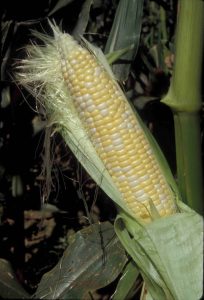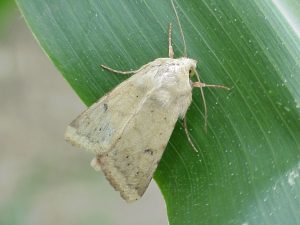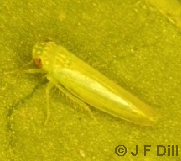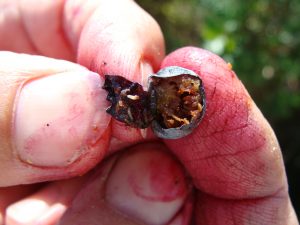Sweet Corn IPM Newsletter No. 9 – August 18, 2017
 Sweet Corn IPM Newsletter No. 9 – August 18, 2017
Sweet Corn IPM Newsletter No. 9 – August 18, 2017
Click on photos to enlarge.
COOL NIGHTS SLOW INSECT ACTIVITY
Silking Corn Still Needs Protection in Most Fields
SITUATION
Cool nights and dry conditions have slowed corn development, and pushed expected harvests dates back, leading to a short supply of sweet corn in some areas. Expected rain over the weekend and warmer temperatures next week should help the situation. Insect pressure has been somewhat lighter this week, although most fields still require protection for silking corn.
European corn borer: Moth counts have been spotty around the state. Most locations continue to see no moths, but counts have increased in a few fields. Fields in North Berwick and Poland Spring were over the 5-moth threshold for silking corn, but both sites are also under a spray interval for corn earworm, so no additional sprays should be needed. Larval feeding injury was low, with most of the injury on late corn due to fall armyworm.

Corn earworm: Moth counts were generally lower in most locations this week, but still high enough to warrant a tight spray schedule for silking corn in most fields. A 6-day spray interval for corn earworm was recommended for silking fields in Wayne. A 5-day spray schedule was recommended in Bowdoinham, one Cape Elizabeth site, Levant, Poland Spring and one Wells site. A 4-day spray interval was recommended in Auburn, one Cape Elizabeth site, Lewiston, New Gloucester, Nobleboro, North Berwick, Sabattus and one Wells site.

Fall armyworm: Similar to corn earworm, moth counts were mostly lower this week, although several sites were over the 3-moth threshold for silking corn. A spray for fall armyworm on silking corn was recommended in Biddeford. Other sites, including Cape Elizabeth, New Gloucester, Nobleboro, Poland Spring, and Wells were also over the 3-moth threshold, but are now on a spray schedule for corn earworm. Larval feeding damage in younger corn was also lower this week. Fields in Auburn, Cape Elizabeth, New Gloucester, Poland Spring and Wells were over the 15% injury threshold, and sprays for pre-tassel to tassel corn were recommended.

Potato leafhopper alert: We are still seeing signs of potato leafhopper in vegetable and strawberry fields this week. These small, green bullet-shaped insects feed on plant sap from the undersides of leaves, causing the leaves to become curled, stunted and yellow-streaked. Beans are often the first crop to show symptoms, but other crops are also susceptible, including potatoes and strawberries. Controls for potato leafhoppers are listed in the New England Vegetable Management Guide.
Squash vine borer: Counts were quite low this week, with no fields over the control threshold, which agrees with data from NH. There is the possibility of a second generation emerging over the next few weeks that could threaten late squash and pumpkins or attack ripening fruit.

Spotted wing drosophila: Numbers have been increasing over the past week, and now threaten any soft fruit in the field, such as late raspberries and blueberries. Regular sprays will be needed to prevent such fruit from becoming infested with larvae. Visit our Spotted Wing Drosophila blog for more information.
Sincerely,
David T. Handley
Vegetable and Small Fruit Specialist
Highmoor Farm, P.O. Box 179, 52 US Route 202, Monmouth, ME 04259, 207.933.2100
UMaine Extension Diagnostic Research Lab, Pest Management Unit, 17 Godfrey Drive, Orono, ME 04473, 1.800.287.0279
| Location | CEW Moths |
ECB Moths |
FAW Moths |
% Feeding Damage |
Recommendations / Comments |
|---|---|---|---|---|---|
| Auburn | 18 | 0 | 2 | 47% | 4-day spray interval recommended on all silking corn |
| Biddeford | 0 | 0 | 3 | 2% | One spray recommended for FAW |
| Bowdoinham | 5 | 0 | 2 | 7% | 5-day spray interval recommended on all silking corn |
| Cape Elizabeth I | 6 | 1 | 0 | 20% | 5-day spray interval recommended on all silking corn |
| Cape Elizabeth II | 8 | 9 | 4-day spray interval recommended on all silking corn | ||
| Charleston | 1 | 1 | 0 | No spray recommended | |
| Dayton | 5 | 1 | 1 | 1% | 5-day spray interval recommended on all silking corn |
| Farmington | 0 | 0 | 0 | 5% | No spray recommended |
| Lewiston | 8 | 1 | 1 | 4-day spray interval recommended on all silking corn | |
| Garland | 0 | 2 | 0 | 3% | No spray recommended |
| Levant | 5 | 2 | 3 | 2% | 5-day spray interval recommended on all silking corn |
| Monmouth | 0 | 0 | 1 | 14% | No spray recommended |
| New Gloucester | 30 | 0 | 28 | 16% | 4-day spray interval recommended on all silking corn |
| Nobleboro | 12 | 1 | 3 | 4-day spray interval recommended on all silking corn | |
| North Berwick | 15 | 5 | 1 | 3% | 4-day spray interval recommended on all silking corn |
| Oxford | 0 | 0 | 1 | 0% | No spray recommended |
| Palmyra | 0 | 0 | 1 | 0% | No spray recommended |
| Poland Spring | 6 | 9 | 15 | 20% | 5-day spray interval recommended on all silking corn |
| Sabattus | 10 | 0 | 0 | 0% | 4-day spray interval recommended on all silking corn |
| Wales | 1 | 0 | 0 | 0% | No spray recommended |
| Wayne | 3 | 0 | 0 | 6-day spray interval recommended on all silking corn | |
| Wells I | 6 | 0 | 2 | 25% | 5-day spray interval recommended on all silking corn |
| Wells II | 9 | 0 | 11 | 5% | 4-day spray interval recommended on all silking corn |
CEW: Corn earworm (Only fresh silking corn should be sprayed for this insect.)
ECB: European corn borer
FAW: Fall armyworm
| Moths caught per week | Moths caught per night | Spray interval |
|---|---|---|
| 0.0 to 1.4 | 0.0 to 0.2 | No spray |
| 1.5 to 3.5 | 0.3 to 0.5 | Spray every 6 days |
| 3.6 to 7.0 | 0.6 to 1.0 | Spray every 5 days |
| 7.1 to 91 | 1.1 to 13.0 | Spray every 4 days |
| More than 91 | More than 13 | Spray every 3 days |
Thresholds apply only to corn with exposed fresh silk. Lengthen spray intervals by one day if maximum daily temperature is less than 80°F.
European Corn Borer Thresholds
Whorl stage: 30% or more of plants scouted show injury.
Pre-tassel-silk: 15% or more of plants scouted show injury.
Silk: 5 or more moths caught in pheromone traps in one week.
IPM Web Pages:
UMaine Cooperative Extension Integrated Pest Management
Penn State Pest Watch for Sweet Corn
UMass Amherst Integrated Pest Management
Where brand names or company names are used, it is for the reader’s information. No endorsement is implied nor is any discrimination intended against other products with similar ingredients. Always consult product labels for rates, application instructions and safety precautions. Users of these products assume all associated risks.
The University of Maine is an equal opportunity/affirmative action institution.
